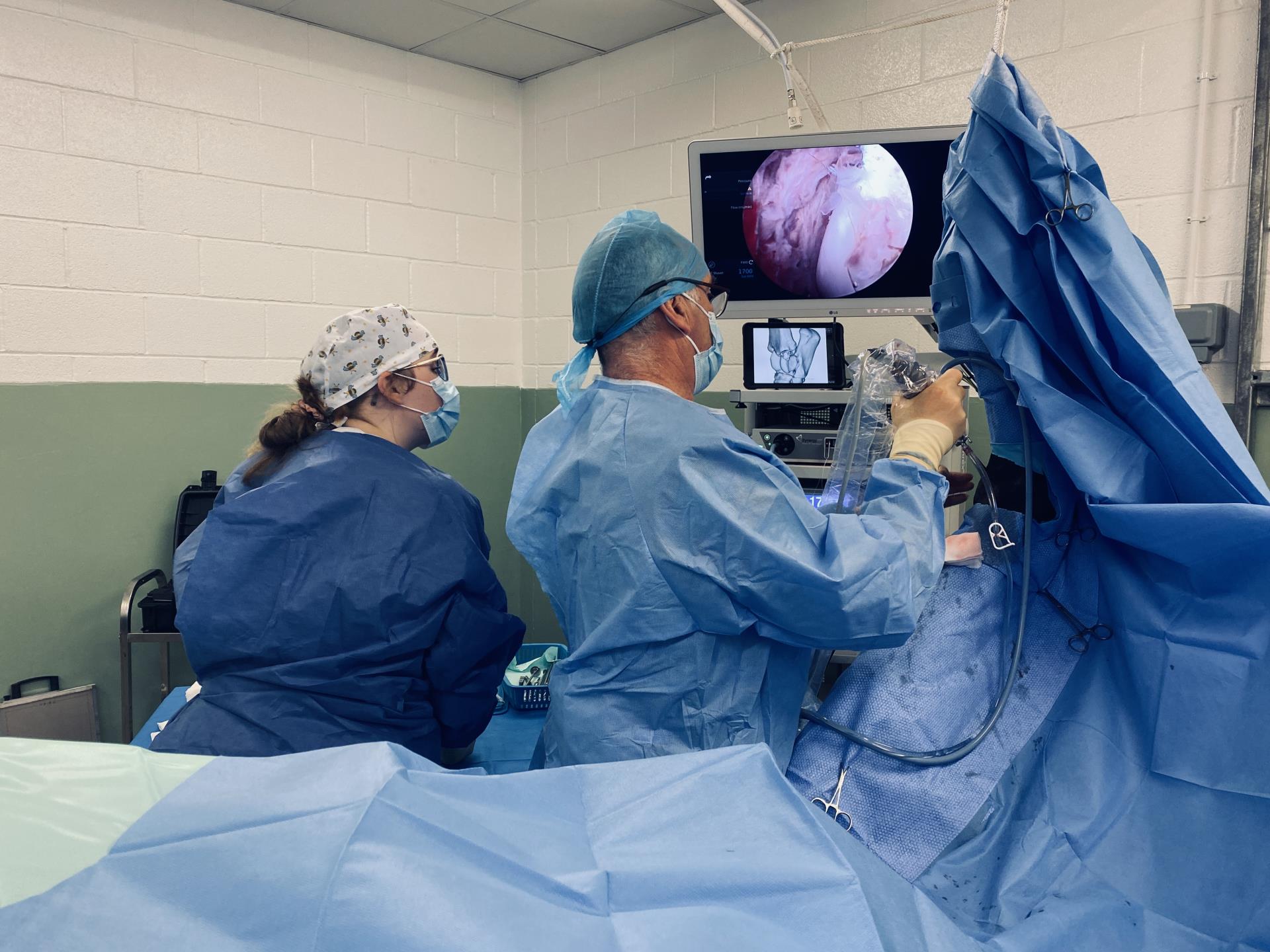Elective Arthroscopy Information
Arthroscopy is a minimally invasive surgical procedure performed on a synovial structure such as a joint, tendon sheath or bursa in which an examination, and sometimes treatment of damage, is performed using an arthroscope. An arthroscope is a small rigid camera that is inserted into the area of interest through a small (around 1cm) incision. The advantage over traditional open surgery is that the joint or tendon sheath does not have to be opened up fully and only a few small incisions are made, one for the arthroscope and others for the surgical instruments that are used within the joint cavity. This reduces recovery time and may increase the rate of success due to reduced trauma to the connective tissue. Sterile irrigation fluid is used to distend the joint and improve visualisation.
 The surgeon views the joint on a video monitor, and can diagnose
The surgeon views the joint on a video monitor, and can diagnose
and debride torn/damaged tissue, such as tendon and cartilage, as well as remove bone fragments. Following the surgery the small incisions are closed with skin sutures and the limb is dressed. At B&W, the surgery is performed by one or two of our specialist surgeons, assisted by a team of nurses. The surgery is performed under a general anesthetic which is monitored by a veterinary surgeon.
What to expect
- We will ask that you bring your horse to the hospital the day before surgery in order for him/her to settle in and be prepared appropriately.
- If your horse is insured we advise that you contact your insurance company before surgery to notify them of the plan; some insurance companies require a report from us prior to surgery.
- A pre-operative blood sample will be taken and run in our in-house laboratory to identify any underlying problems that might increase the risk of undergoing a general anaesthetic or surgery.
- A full clinical examination of your horse is performed, including careful examination of their heart and lungs.
- If no significant abnormalities are detected a small patch will be clipped on your horse’s neck and an intravenous jugular catheter will be placed to enable quick intravenous access during the surgery and administration of medications.
- Shoes are removed at this stage, to reduce the risk of self- injury during recovery from the general anaesthetic. If you would prefer, your farrier can remove the shoes before your horse comes in.
- The horse is groomed and the surgical site is clipped and has a preliminary cleansing scrub.
- In order to reduce the risk of complications, a short period of starvation is necessary pre-operatively.
- On the day of surgery, preparation of your horse will begin roughly an hour before surgery. The surgical site will be scrubbed further and the pre-anaesthetic medication, including a sedative, antibiotic and painkiller are given half an hour before surgery.
- Your horse will then be taken to the padded induction box where anaesthesia will be induced. Once anaesthetised, a mechanical hoist is used to lift the horse onto the operating table.
- At the end of surgery, your horse will be moved into the padded recovery box and given oxygen. The recovery is monitored carefully and any assistance given as necessary. Recovery time varies from horse to horse.
- You will receive a phone call as soon as your horse is up after the general anaesthetic. This is normally from a member of the reception team as the surgeon often stays in theatre to begin the next case.
- Once the horse has recovered sufficiently, he or she will be taken back to the stables and fed a series of mashes.
- We advise that owners do not visit on the day of surgery.
- Your horse will be carefully monitored post-operatively to ensure he/she remains comfortable. Colic is one of the complications occasionally seen in the post-operative period. Once your horse begins passing droppings we will start to re-introduce hay/haylage to their diet.
- You will receive a phone call from the surgeon later on in the day giving you a full update on the surgery itself. This call can sometimes be quite late in the evening if it has been a busy day of operating, or if emergencies arise.
- Horses undergoing elective arthroscopy often remain in the hospital for at least 36-48 hours post-operatively, in order for them to be monitored closely and receive a course of intravenous antibiotics
 The surgeon views the joint on a video monitor, and can diagnose
The surgeon views the joint on a video monitor, and can diagnose